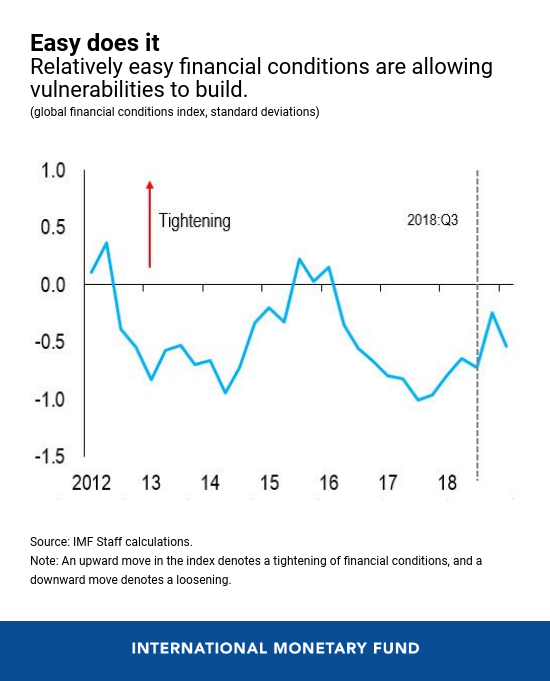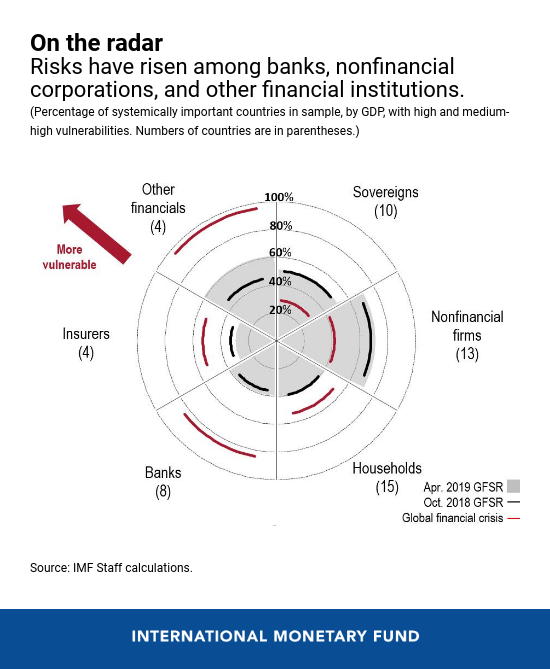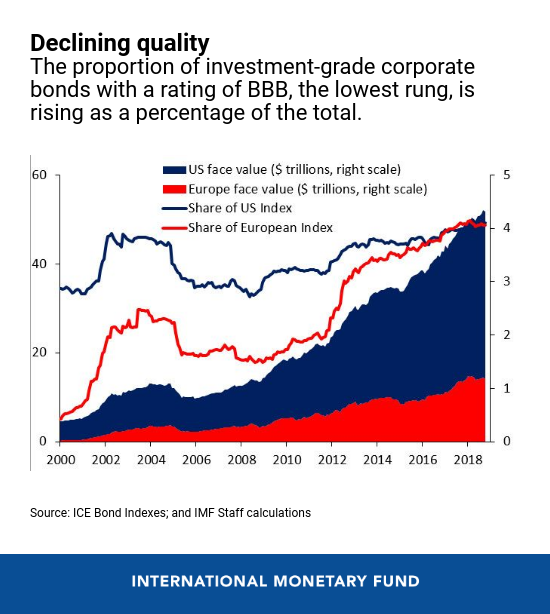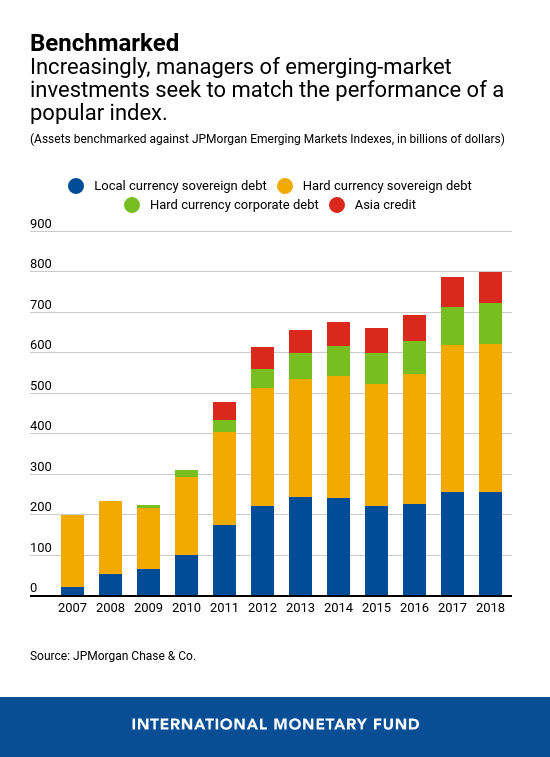عربي, 中文, Español, Français, 日本語, Português, Русский
In the United States, the ratio of corporate debt to GDP is at record-high levels. In several European countries, banks are overloaded with government bonds. In China, bank profitability is declining, and capital levels remain low at small and medium-size lenders.
Vulnerabilities like these are on the rise across advanced and emerging market economies, according to the IMF’s latest Global Financial Stability Report. They aren’t all setting off alarm bells just yet. But if they continue to build, especially with still-easy financial conditions, they could amplify shocks to the global economy, raising the odds of a severe economic downturn a few years down the road.
With the right mix of policies, countries can sustain growth while keeping vulnerabilities in check.
This poses a dilemma for policymakers seeking to counter a slowing global economy, as discussed in the World Economic Outlook. By taking a patient approach to monetary policy, central banks can accommodate growing downside risks to the economy. But if financial conditions remain easy for too long, vulnerabilities will continue to build, and the odds of a sharp drop in economic growth at some later point will be higher.
The good news: short-term risks to global financial stability are still low by historical standards, though they are slightly higher than we found in our October 2018 Global Financial Stability Report . In the medium term, however, risks remain elevated. But with the right mix of policies, countries can sustain growth while keeping vulnerabilities in check.
Why do we worry about financial vulnerabilities? Because they can amplify the impact of sudden shocks—such as a sharper-than-anticipated economic slowdown, an unexpected shift in monetary policy, or an escalation of trade tensions. Higher vulnerabilities give rise to greater financial stability risks.
The latest Global Financial Stability Report introduces a way to quantify vulnerabilities in the financial system, so policymakers can monitor them in real time and take preventive steps if needed to mitigate risks. The framework encompasses six sectors: corporates, households, governments, banks, insurance companies, and other financial institutions—some of which are what we call “shadow banks.”
The framework tracks both the level and the pace of change along a variety of vulnerabilities, including leverage and mismatches in the maturity and liquidity of assets and liabilities, as well as currency exposures. These vulnerabilities are tracked at regional and global levels, aggregating across 29 systemically important countries.
Here are some of the most serious vulnerabilities:
Advanced economies. Corporate debt and financial risk-taking have increased, and the creditworthiness of borrowers has deteriorated. The stock of bonds with BBB ratings has quadrupled, and the stock of speculative-grade credits has almost doubled in the United States and the euro area since the crisis. A sharp tightening of financial conditions or a severe downturn could make it harder for indebted firms to repay their loans and force them to cut back on investment or employment. So-called leveraged loans to highly indebted borrowers are an area of particular concern, as we explained in an earlier blog and discuss further in the current GFSR.
-
Euro area. Fiscal challenges in some countries could drive bond yields sharply higher, resulting in significant losses for banks with large holdings of government debt. Insurance companies could also face losses. This dynamic, known as the sovereign-financial sector nexus, was at the heart of the euro crisis in 2011. Still, banks have higher capital ratios today, and policymakers have taken steps to address nonperforming loans on banks’ balance sheets.
-
China. A decline in profits and low levels of capital at small and medium-sized banks is restraining credit to smaller private firms. Further monetary and credit support may increase financial stability risks, as continued credit growth makes it harder for smaller banks to clean up their balance sheets.
-
Emerging markets. Increasingly, overseas portfolio investments in emerging markets are run by managers who seek to match the returns of popular indexes. The value of fixed-income, benchmark-driven investments has quadrupled in the past ten years to $800 billion. While index-driven funds expand the universe of investors for emerging market economies, they also leave them more vulnerable to sudden reversals of capital flows in response global trends.
Fortunately, there are ways to address such vulnerabilities:
-
So-called macroprudential tools can cool credit growth and make the financial system more resilient. One example: countercyclical capital buffers, which require banks to increase capital when credit is growing.
-
Countries with high corporate debt could develop tools to limit the riskiness of credit to firms—especially credit provided by nonbank lenders.
-
In the euro zone, lowering the debt-to-GDP ratio among highly indebted governments is a priority to curb risks. So is further repairing banks’ balance sheets, including by reducing non-performing loans.
-
China needs to continue reducing leverage in the financial sector, especially in shadow banking, and ensure that lenders build capital buffers. Authorities should also promptly carry out announced reforms to address risks in investment products.
-
Emerging market economies coping with volatile capital flows could limit reliance on short-term overseas debt and ensure adequate foreign currency reserves and fiscal buffers. Countries can also use flexible exchange rates to absorb shocks.
In some circumstances, countries with strong economies and inflation at or above target can also consider using monetary policy to “lean against the wind.” With the right combination of policies, countries can keep their economies humming while also limiting risks to financial stability.









